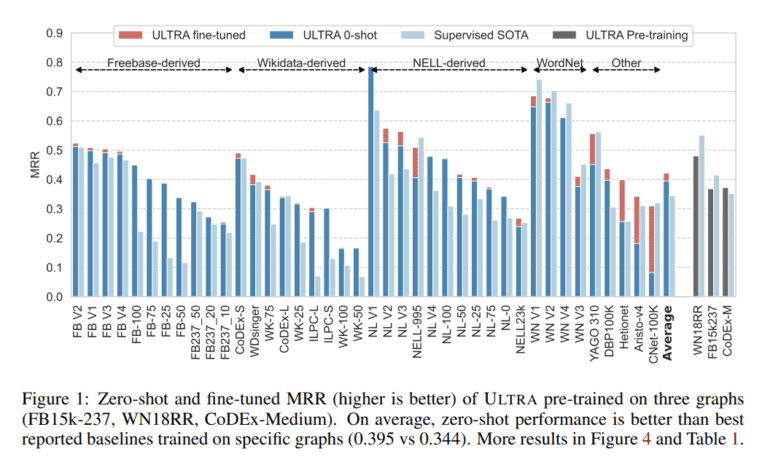TL;DR:
- ULTRA is a groundbreaking model for knowledge graph reasoning.
- It creates universal and transferable graph representations, outperforming specialized models.
- Researchers from various institutes collaborated to develop ULTRA.
- It overcomes challenges related to diverse entity and relation vocabularies.
- ULTRA’s three-step algorithm underpins its impressive performance.
- Fine-tuning enhances ULTRA’s competitiveness, especially on smaller inductive graphs.
- ULTRA consistently outperforms tailored supervised baselines across 57 KGs.
- Future work includes exploring relation-to-relation interactions and comprehensive evaluation metrics.
- ULTRA’s potential promises a bright future for knowledge graph reasoning.
Main AI News:
In the ever-evolving landscape of knowledge graph reasoning, a groundbreaking innovation has emerged – ULTRA. This cutting-edge model is not just another contender; it’s a game-changer. ULTRA is designed to revolutionize the way we approach knowledge graphs (KGs) and their representations, offering universal and transferable solutions that outshine even the most specialized models.
ULTRA’s Unique Approach
ULTRA is not your typical KG model. Unlike its predecessors, which heavily rely on textual information, ULTRA takes a different path. It forges its path to knowledge by creating relational illustrations, and here’s the kicker – it does so by conditioning these illustrations on interactions. This unique approach empowers ULTRA to adapt and generalize seamlessly across various KGs, each with its distinct entity and relation vocabularies.
Impressive Zero-Shot Inductive Inference
Picture this: ULTRA, pre-trained and primed, stepping onto new graphs for link prediction experiments and consistently outperforming the competition. It’s a reality. ULTRA’s zero-shot inductive inference capabilities are nothing short of remarkable. It confidently strides into uncharted territory, demonstrating its prowess in ways that specialized baselines can only dream of.
A Collaborative Effort
The birth of ULTRA is the result of a collaborative effort by researchers from esteemed institutes worldwide. Their mission? To create foundational models for KGs that are capable of universal inference. ULTRA is the embodiment of their vision, and it stands as a testament to their dedication and expertise.
Overcoming Challenges
One of the biggest challenges in KGs is the diversity of entity and relation vocabularies. Traditional pre-training and fine-tuning methods, which have proven successful in domains like language and vision, struggle to adapt to this diversity. ULTRA rises to the occasion by offering a novel approach – learning universal graph representations. This approach allows it to seamlessly transfer its knowledge to new KGs, regardless of their relations and structures.
The Three-Step Algorithm
ULTRA’s power lies in its three-step algorithm:
- Lifting the graph
- Obtaining relation representations conditioned on queries
- Predicting links
This algorithm forms the backbone of ULTRA’s impressive performance, enabling it to outshine specialized baselines across 57 KGs.
Fine-Tuning for Excellence
Fine-tuning is where ULTRA takes its performance to the next level. It effectively narrows the gap between pre-training and baseline results, making ULTRA not just competitive but often superior to models trained specifically for certain graphs. The results speak for themselves, with ULTRA shining on smaller inductive graphs, achieving nearly three times better performance in cases like FB-25 and FB-50.
A Bright Future Ahead
In conclusion, ULTRA is a game-changer in the world of knowledge graph reasoning. Its universal and transferable graph representations set it apart, excelling in training and inference across diverse multi-relational graphs without the need for input features. It consistently outperforms tailored supervised baselines, even in zero-shot scenarios, by an average margin of 15. ULTRA’s potential is boundless, making it a promising choice for inductive and transferable knowledge graph reasoning.
Looking Ahead
As we venture into the future of knowledge graph reasoning, ULTRA leaves us with tantalizing prospects. Future work may explore strategies for capturing intricate relation-to-relation interactions. Additionally, there’s a pressing need for comprehensive evaluation metrics beyond Hits10, offering a deeper understanding of ULTRA’s capabilities. The research community is encouraged to delve into the untapped potential of transfer learning in KG representation and to seek innovative inductive learning methods that can adapt to KGs with varying relation sets. The path ahead is bright, and ULTRA is leading the way.
Conclusion:
ULTRA’s emergence signifies a transformative shift in the knowledge graph reasoning market. Businesses can leverage its universal and transferable graph representations to gain a competitive edge, surpassing traditional models. The collaboration of researchers underscores the importance of this innovation. ULTRA’s adaptability to diverse vocabularies and its impressive performance on various KGs make it an invaluable asset for businesses seeking efficient and effective knowledge graph reasoning solutions. As the market evolves, ULTRA’s capabilities position it as a frontrunner for businesses looking to harness the power of knowledge graphs.

